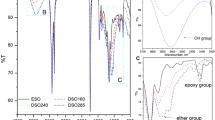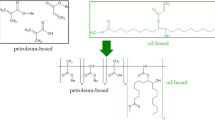Abstract
Soy oil glycol monoesters have been prepared through the transesterification of soybean oil with ethylene, diethylene, propylene, and dipropylene glycols. The molar ratio of soybean oil to glycol used in these reactions was 1∶6. The catalyst used in these reactions was lithium carbonate, 0.5%, based on soybean oil. The transesterifications were carried out at 180–190°C. The composition of soy oil glycol esters and their physical properties were determined. The soy oil glycol esters were incorporated in a water-based paint formulation as the coalescent aid, and the minimum film formation temperature was determined. The minimum film formation temperature results indicated that these esters can be used as coalescent aids in latex paint formulations to help in continuous film formation at or below room temperature.
Similar content being viewed by others
References
Wicks, Z.W., Jr., Jones, F.N., and Pappas, S.P., Organic Coatings Science and Technology, 2nd edn., John Wiley & Sons, New York, 1999, pp. 33–36.
Turner, G.P.A., Introduction to Paint Chemistry, 3rd edn., Chapman and Hall, London, 1988, pp. 144–149.
Winnik, M.A., Y. Wang, and F. Haley, Latex Film Formation at the Molecular Level: The Effect of Coalescent Aids on Polymer Diffusion, J. Coatings Technol. 64(no. 811):51–61 (1992).
Hoy, K.L., Effect of Reaction Pathway on Emulsion Polymer Structure, ——Ibid. 51(no. 651):27–41 (1979).
Vanderhoff, J.W., E.B. Bradford, and W.K. Carrington, Transport of Water Through Latex Films, J. Polym. Sci. Symp. 41: 155–174 (1973).
Protzman, T.F., and G.L. Brown, An Apparatus of the Determination of the Minimum Film Formation Temperature of Polymer Emulsions, J. Appl. Polym. Sci. 4:81–85 (1960).
Eckersky, S.T., and A. Rudin, Mechanism of Film Formation from Polymer Latexes, J. Coatings Technol. 62(no. 780) 89–100 (1900).
Croll, S.G., Drying of Latex Paint, ——Ibid. 58(no. 734):41–49 (1986).
Eckersky, S.T., A. Rudin and R. O'Daiskey, Surface Energetics of Films of Surfactant Free Poly (methyl methacrylate-co-butyl acrylate) Emulsion Polymers, J. Colloid Interface Sci. 152: 455–464 (1992).
Wicks, Z.W., Jr., Drying Oils, in Encyclopedia of Polymer Science and Technology, Wiley-Interscience, New York, 1986, Vol. 5, pp. 203–214.
Basu, H.N., E.M. Robley, and M.E. Norris, Preparation of Glycol Derivatives of Partially Hydrogenated Soybean Oil Fatty Acids and Their Potential as Lubricants, J. Am. Oil Chem. Soc. 71:1227–1230 (1994).
Clark, S.J., L. Wagner, M.D. Schrock, and P.G. Piennaar, Methyl and Ethyl Soybean Oil Esters as Renewable Fuel, ——Ibid. 61:1632–1638 (1984).
Hall, D., Put a Sunflower in Your Tank, New Sci. (26 Feb): 524–526 (1981).
ASTM D1331-89, Standard Test Method for Surface Tension Determination by the Ring Method Tensiometer, ASTM, Philadelphia, 1997, 15.04, pp. 1–3.
Schick, M.J., Nonionic Surfactants Physical Chemistry, Marcel Dekker, New York, 1987, p. 438.
Alan Barto, F.M., Handbook of Solubility Parameters, CRC Press, Boca Raton, 1991, pp. 182–185.
ASTM D1475-90, Standard Test Method for Density Determination, section 6, vol. 6.01, ASTM, Philadelphia, 1993, pp. 229–231.
ASTM D2354-91, Standard Test Method for Minimum Film Formation Temperature of Emulsion Vehicles, section 6, vol. 6.02, ASTM, Philadelphia, 1993, pp. 104–105.
Wehrli, F.W., A.P. Marchand, and S. Wehsli, Interpretation of Carbon-13 NMR Spectra, John Wiley & Sons, New York, 1989, pp. 410–412.
Breitmeier, E., and W. Voelter, C-13 NMR Spectroscopy: High Resolution Methods and Applications in Organic Chemistry and Biochemistry, John Wiley & Son, 3rd edn, New York, 1987, p. 119.
Marshall, G.L., and J.A. Lander, Characterization of Alkyd Paint Binder Using C-13 NMR Spectroscopy, Eur. Polym. J. 21: 949–958 (1985).
Brandrup, J., and E.H. Immergut, Polymer Handbook, 2nd edn., Wiley-Interscience, New York, 1989, p. 519.
Rosen, M.J., Surfactants and Interfacial Phenomena, 2nd edn., John Wiley & Sons, New York, 1989, pp. 207–211.
ASTM D 3539-87, Standard Test Method for Evaporation Rates of Volatile Liquids, section 6, vol. 6.01, pp. 459–466, ASTM, Philadelphia, 1993.
Author information
Authors and Affiliations
Corresponding author
About this article
Cite this article
Jiratumnukul, N., Van De Mark, M.R. Preparation of glycol esters of soybean oil fatty acids and their potential as coalescent aids in paint formulations. J Amer Oil Chem Soc 77, 691–697 (2000). https://doi.org/10.1007/s11746-000-0111-8
Received:
Accepted:
Issue Date:
DOI: https://doi.org/10.1007/s11746-000-0111-8




